
Andy Lloyd's Dark Star Blog

Blog 54 (September 2017)
A Hot Jupiter as Dark as Asphalt
A sub-brown dwarf planet has been found to be as black as asphalt (1). The pitch-black nature of the 'hot Jupiter' world known as Wasp-12b brings this object very close indeed to my decades-old description of a 'Dark Star' (2). This strange world is an exoplanet between two and three times the size of Jupiter (but about 1.4 times its mass) which is orbiting incredibly close to its parent star, WASP-12A, located about 1,400 light years away. Its proximity to the star has distorted its ballooning shape into that of an egg, and has created surface temperatures of approximately 2600 degrees Celsius.
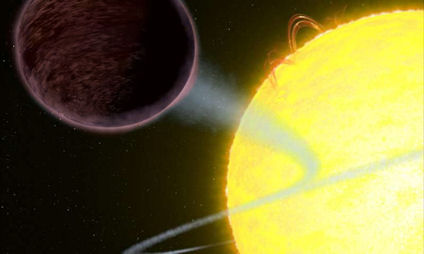
Image Credit: NASA, ESA, and G. Bacon (STScI)
Although this exoplanet has been known about for a while, and well-studied, the Hubble Space Telescope recently imaged it whilst eclipsing its parent star, allowing its atmosphere to be studied, and its albedo, or reflectivity, to be calculated. The results are remarkable, indicating that this hot planet is as black as fresh asphalt:
"The daylight side of WASP-12b is so hot that clouds cannot form and alkali metals are ionised. It is even hot enough to break up hydrogen molecules into atomic hydrogen which causes the atmosphere to act more like the atmosphere of a low-mass star than like a planetary atmosphere. This leads to the low albedo of the exoplanet. WASP-12b... is not reflecting light at any wavelength. WASP-12b does, however, emit light because of its high temperature, giving it a red hue similar to a hot glowing metal." (1)
The results were unexpected, and very much at odds with the only other hot Jupiter to have been imaged in this way, showing how diverse the properties of these worlds can be. In the case of WASP-12b, which absorbs more than 94% of the light striking it, the nature of its atmospheric conditions has had to be completely reviewed:
"We use our eclipse depth limits to test two previously suggested atmospheric models for this planet: Mie scattering from an aluminum-oxide haze or cloud-free Rayleigh scattering. Our stringent nondetection rules out both models and is consistent with thermal emission plus weak Rayleigh scattering from atomic hydrogen and helium." (3)
This hot Jupiter world was detectable because of the gravitational effect it has upon its parent star, causing the star to wobble. It would be practically impossible, then, to detect a dark Jupiter-sized world like this using visible light. If its remarkable atmospheric conditions, and extremely low albedo, are functions of the heating effects of its proximity to its parent star, then this creates no precedent beyond its own class of hot Jupiter. But, one must wonder whether there are other worlds out there, located in a more 'normal' position around stars, or free-floating in interplanetary space, which are similarly dark, and thus incredibly well hidden from our sight.
Written by Andy Lloyd, 17th September 2017
References:
1) "Hubble captures blistering pitch-black planet" 14 September 2017, with thanks to Je
2) Andy Lloyd "The Dark Star Theory" Feb 2000
3) Taylor Bell et al. "The Very Low Albedo of WASP-12b from Spectral Eclipse Observations with Hubble", The Astrophysical Journal 2017, 847: (1),
Planet Nine Probably Formed in Solar System
Although there has been no news yet about the whereabouts of Planet Nine, the super-Earth/mini-Neptune shaped Planet X object now thought by many astronomers to be lurking in the outer solar system (1), there is no shortage of theoretical work going on to determine the origin of this elusive object. Because of the normal size of protoplanetary disks around young stars, there is insufficient material at the distances Planet Nine is likely to be located for it to have formed. So, its presence, if confirmed, would need to be explained in other ways.
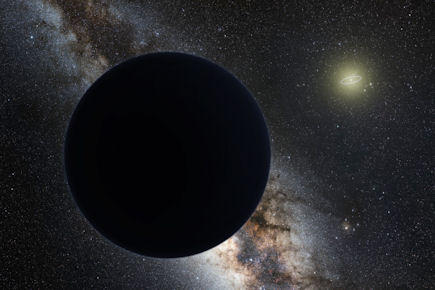
Image credit: ESO/Tomruen/nagualdesign
It may fit into the generally accepted Nice model of solar system formation as an early protoplanet which migrated outwards during a period of high volatility when the major planets were shuffling around rather chaotically. Any ejected world would most likely end up entirely cast out of the solar system, but there's a working chance that it hung onto the system's cliff edge by its fingernails.
A second scenario is that Planet Nine may have been an exoplanet, born of another system, which was captured by the Sun in the early lifetime of the solar system (2). Neither of these scenarios would have been considered very likely a generation ago, but the discovery of a menagerie of bizarre exoplanets has raised the awareness of many that the universe produces many oddities. Possibly this is just how statistics work. Even if the odds against something happen seem remote, if you spread your gaze across millions of star systems, then you'll still end up finding these oddities. Perhaps, then the solar system has thrown up Planet nine as just one of these oddities.
But, despite the rationalism of science, we humans retain just a bit of pride in our local cosmic hunting ground, and tend to think that we're somehow special, or have the perfect conditions, or whatever (think of the argument for life in the Cosmos). So, where the Earthly bird of paradise sits on a perch of perfection, Planet Nine is more like a misfit mongrel locked away in the cupboard. It doesn't fit, it shouldn't be there, and if we stop paying attention to that irritating baying noise, it'll simply go away. So, there have been several calculations done using powerful computers which indicate the low probability of Planet Nine's formation.
The latest academic attempt to model the origin of Planet Nine comes from an international team led by Richard Parker of the University of Sheffield (3). Using advanced computer programs, they simulated the Sun's original star-forming region of space - likely a much denser cluster of stars than our current galactic environment - and then adjusted the model to make it as easy as possible for a star to capture a planet from one of its siblings (4).
Here's part of the abstract from their new paper:
"We use N-body simulations to investigate the probability that Planet 9 was a free-floating planet (FFLOP) that was captured by the Sun in its birth star-formation environment. We find that only 1 - 6 per cent of FFLOPs are ensnared by stars, even with the most optimal initial conditions for capture in star-forming regions (one FFLOP per star, and highly correlated stellar velocities to facilitate capture). Depending on the initial conditions of the star-forming regions, only 5 - 10 of 10000 planets are captured onto orbits that lie within the constraints for Planet 9. When we apply an additional environmental constraint for Solar system formation - namely the injection of short-lived radioisotopes into the Sun's protoplanetary disc from supernovae - we find that the probability for the capture of Planet 9 to be almost zero." (3)
Lots of assumptions in this work, of course, perhaps all of which are well-founded theoretically, although the population of free-floating planets compared to stars is pretty much guesswork at this stage, given how incredibly difficult FFLOPS (great name) are to find. The upshot of this is that Planet Nine has a vanishingly low chance of being a captured exoplanet, even if it's from a neighbouring 'stellar sibling' (5). These stellar siblings may even include a birth twin of the Sun - there is evidence to suggest that all stars are born with companions of one form or another, which become separated early on (6). So, maybe this latest work isn't being as generous towards the 'capture' scenario as they're making out.
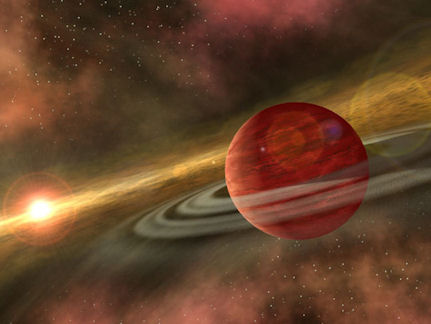
Personally, I think the ability for planets to form and grow has been grossly underestimated (7), and that there is a third scenario to consider, one which I am currently fleshing out in a new book. Accretion of sizeable planets in the outer solar system has been looked on favourably by some academic theorists (8), although this is hardly a widely held opinion. Probably because there has never been a need to create such mechanisms. Science has always had to adjust to new data. Sometimes it embraces it, sometimes it has to be dragged to the truth kicking and screaming. I think the existence of Planet X would create such a step-change, and in this I'm not alone:
"Once astronomers figure out whether Planet Nine is real they can work out how it formed. “If it’s out there and it’s really on this strange orbit, we’re going to have to be creative to figure out how it got out there,” says [Kat] Volk [from the University of Arizona]. “And what it tells us about our solar system depends on what formation mechanism we settle on.”" (4)
At the moment, there is no concrete evidence for the existence of Planet Nine (or any other substantial Planet X body), so how it might have got there is a theoretical exercise to entertain the minds of astrophysicists, and push what is thought to be theoretically possible to the very limit. However, once Planet X is found, then the scepticism is cast off and efforts to figure it all out will take on a whole new impetus.
Written by Andy Lloyd, 16th September 2017
References:
1) K. Batygin & M. Brown "Evidence for a Distant Giant Planet in the Solar System" The Astronomical Journal, 151: 2, 20 January 2016,
2) Alexander Mustill et al "Is there an exoplanet in the Solar System?" 23 March 2016
3) Richard Parker, Tim Lichtenberg & Sascha P. Quanz "Was Planet 9 captured in the Sun's natal star-forming region?" Monthly Notices of the Royal Astronomical Society: Letters, 472(1): ppL75–L791 S, November 2017
4) Leah Crane "Our sun probably didn’t steal Planet Nine from outer space" 11 September 2017, with thanks to Lee
5) University of Sheffield Press Release "Astronomers probe origin of Planet 9", 14 September 2017, with thanks to John
6) Andy Lloyd "The Sun was Born with a Companion" 15 June 2017
andylloyd.org/darkstarblog51.htm
7) Andy Lloyd "The Cumulative Effect of Intermittent Interstellar Medium Inundation Upon Objects In The Outer Solar System" Feb 2016, DOI: 10.13140/RG.2.1.5112.5526 - an updated version (22/2/16) is available here:
8) Scott Kenyon et al. "Making Planet Nine: Pebble Accretion at 250--750 AU in a Gravitationally Unstable Ring" 25 March 2016
Origin of the Asteroids
There are two major asteroid belts in the solar system. The traditional belt lies between the planets Mars and Jupiter, and is relatively dense and compact compared with its colder, more distant cousin, the Kuiper Belt. Both belts are thought to have formed with far more materials than they have now. Their populations of objects have dwindled down over time due to collisions, scattering encounters, and so on.
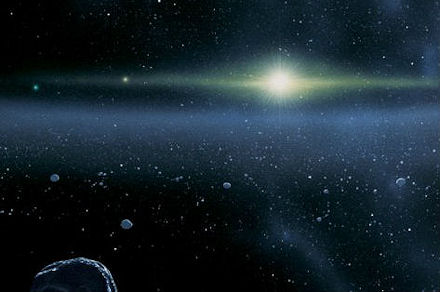
But is this necessarily the case? There have been many arguments made down the years that the main asteroid belt was once a planet in its own right which was impacted by a rogue body (1), or that an hypothesised fifth inner planet (known as Planet V) was perturbed into an asteroid belt-crossing orbit (2). Both of these scenarios would explain the phenomenon known as the late, heavy bombardment, which took places over a few hundred million year, starting about 3.9 billion years ago. The break-up of a large planet within the current asteroid belt has also been considered by astronomers down the years, but is thought to be a highly improbable event (3). Instead, the accretion of smaller planetary embryos may have driven scattering in the region.
Alternatively, Jupiter's massive gravitational effect on this region is a possible factor, including its resonance relationships with Saturn, and their wider involvement in the migration of gas and ice giants during an unstable phase of the early solar system. This is part of the generally accepted theory known as the 'Nice model' of solar system evolution, where gaseous pressures within the protoplanetary disk are thought to drive significant planetary migration. These excursions may have involved one or more now missing additional giant planets or giant planetary embryos (4), which were ejected from the solar system. The Planet Nine hypothesis gives a nod to this model by arguing that the proposed planet was originally just such an ejected planetary embryo (5).
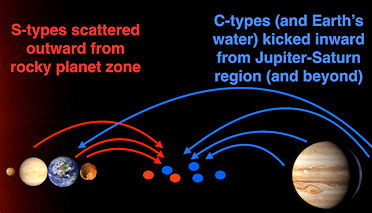
Image credit: Sean Raymond
But, despite the lack of clarity about what might have been the composition of this region in the solar system early on, the general principle is that something was there. A new idea has now been put forward, challenging this central assumption (6). Working from the a priori premise that the current area occupied by the asteroid belt was originally just a gap of empty space between rings ('annuli') of accreting dust and gas, two scientists from the Université de Bordeaux have used computer simulations to show how the present materials may have been sourced from other parts of the solar system. They noted that the compositional make-up of the inner and outer parts of the asteroid belt vary. That variation reflects the building blocks commonly seen on either side of the belt:
"The researchers note that asteroids closer to the rocky planets (called S-type asteroids) tend to contain silicate, similar to the inner planets. By contrast, asteroids in the belt closer to the gas giants (called C-type asteroids) tend to contain more carbon, making them more like the gas giants. This, the researchers note, suggests that the asteroids actually came from the planets as they were forming—excess material was essentially kicked away into the asteroid belt, where it remains today." (7)
Therefore, the researchers argue, the asteroid belt may be a conglomeration of building materials left over from the early stages of the solar system, driven both outwards from the inner system of rocky planets, and inwards from the gas giants beyond. In other words, the asteroid belt is a big pile of left-over rubble, dividing the two main planet-forming regions of the solar system. The objects within the asteroid belt did not start there, they argue, but are instead refugees from other planet-forming zones, or rings, of the protoplanetary disk. Their computer simulations support that possibility, although that's far from offering proof for this controversial hypothesis.
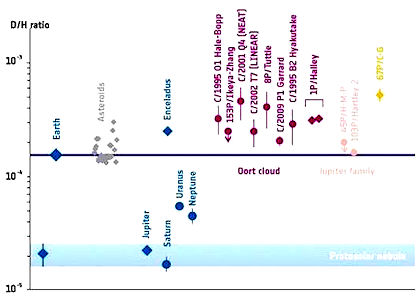
The different values of the deuterium-to-hydrogen ratio (D/H) in water observed in various bodies in the solar system.
Image credit: European Space Agency (8)
There's more, though, because the team also argues that the Earth's water is derived from the outer solar system in the same way, from carbon-type materials which make their way into the inner solar system. It's known that Earth's water is chemically similar (shares the same isotopic ratio) as asteroids in the outer belt - the C-types. This implies, then, that Earth's 'late veneer' of water originates from beyond the asteroid belt, from much the same objects that were migrating inwards following the formation of the gas giants. The calculations support this possibility, showing that the widespread scattering of C-type planetessimals could reach Earth-crossing orbits in sufficient number to account for Earth's accumulated waters:
"Our simulations do not include collisional evolution, which grinds planetesimals down in time. We account for this process by calibrating the effective planetesimal mass to the “late veneer” inferred from highly siderophile elements in Earth’s mantle. Earth is thought to have accreted the final 0.5 to 1% of its mass after the last giant impact. If we restrict our simulations to roughly match the timing of the last giant impact, Earth analogs accreted a median of 0.4 to 0.8% of an Earth mass, depending on the exact assumptions. This indicates that the simulated mass deposited in the asteroid belt is a fair representation of reality." (6)
One might counter all of this by pointing out the growing complexity of these various mechanisms. To make the models 'fit', instabilities within the rotating gaseous nebula around the forming Sun form rings of material, which then accrete into planets. Then the remaining nebula materials create enough gas drag effects to cause these outer planets to migrate away from their initially stable resonant birth positions. This unstable period may cause the ejection of early planets, now lost. Also, now, various smaller bodies are caught up in these migratory patterns, and are flung into new zones, previously unoccupied. Like I said, this is hardly Occam's Razor at work here.
I would argue that there is another possibility involving migration, and that is that the Earth itself began life nearer to, or within, the asteroid belt. It would then have maintained its early primordial waters before itself migrating inwards to its current position as a result of a significant cosmic encounter. That event may have also lent a hand in the creation of the present asteroid belt, whose outer reaches contain waters which show a strong isotopic relationship to our own world's water.
"To compare water found in different
celestial bodies, astronomers analyse the relative abundance of
molecules with a slightly different composition. Most notably, they look
at the D/H ratio, comparing 'ordinary' water, composed of two hydrogen
(H) and one oxygen (O) atoms, and semi-heavy water, where one of the
hydrogen atoms appears as deuterium (D), an isotopical form with an
extra neutron....
current models indicate that a broad and diverse range of minor bodies
contributed to the critical role of bringing water to our planet."
(8)
This may include cross-over objects like 'main-belt comets' (9). The migration inwards of the Earth would have involved an encounter with another world, now beyond our sight. This lost world may now be the much sought-after Planet X (1), or Planet Nine (5), the provenance of which remains so deeply mysterious.
Written by Andy Lloyd, 17th September 2017
References:
1) Zecharia Sitchin "The Twelfth Planet" Avon Books 1976
2) J. Chambers & J. Lissauer "A New Dynamical Model for the Lunar Late Heavy Bombardment" Lunar and Planetary Institute Science Conference Abstracts. 2002, 33: 1093.
lpi.usra.edu meeting documents
3) G. Wetherill "Late heavy bombardment of the Moon and terrestrial planets". Proc. Lunar Sci. Conf 6th, 1975, pp. 1539-1561,
4) David Nesvorný & Alessandro Morbidelli "Statistical study of the early solar system’s instability with four, five, and six giant planets", Astron. J., 2012, 144, 117
5) K. Batygin & M. Brown "Evidence for a Distant Giant Planet in the Solar System" The Astronomical Journal, 151: 2, 20 January 2016,
6) Sean Raymond & Andre Isidoro "The empty primordial asteroid belt", Science Advances, 13 Sep 2017: 3: 9, e1701138,
7) Bob Yirka "New theory on origin of the asteroid belt" 14 September 2017, with thanks to Lee
8) European Space Agency "The cosmic water trail uncovered by Herschel" 19 September 2017, with thanks to John
9) Ray Villard "Comet or Asteroid? Hubble Discovers that a Unique Object is a Binary" 20 September 2017, with thanks to Lee

You can keep informed of updates by following me on Twitter:
![]()
Or like my Facebook Page: https://www.facebook.com/darkstarandylloyd